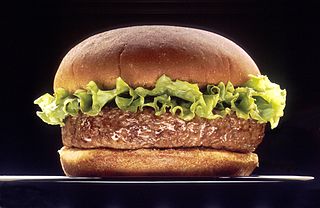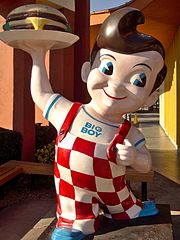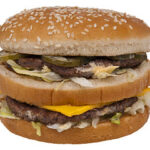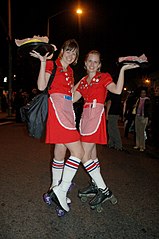
At its most basic version, a hamburger is a sandwich featuring one or more patties of ground meat served inside a bread roll. From here variations begin. Besides meat, hamburgers come with other ingredients inside the bun from lettuce to pickles; tomatoes to onions, and then there’s the sauce. Mustard, ketchup, mayo, or the so-called secret sauce which is a lot like Thousand Island dressing. So many potential choices.

Some say the Menches brothers invented this all-American sandwich at the Erie County Fair [then called the Buffalo County Fair] in 1885. They were selling pork sausage sandwiches when they ran out of pork. So they put in an order with their pork supplier, who repied he wasn’t going to butcher more hogs, because the weather was too hot and the pork might spoil. However, the supplier could sell them ground beef.
Reluctantly, the Menches brothers tested the new product. The first result was dry and bland, so they added coffee and brown sugar to the mix to liven up the flavor, and sold the new sandwich with ketchup and sliced onion. The brothers named their new product a hamburger, because the fair was in the town of Hamburg, New York.
It is unclear whether the Menches brothers created the “first” hamburger, or “one of the first” hamburgers. Another potential creator is Charlie Nagreen who sold his product at the 1885 Seymour Fair. He may be the first to put the hamburger in a bun. Initially, Nagreen sold hamburger steaks from his street stall, but people wanted to walk around the fair while they ate. The solution: the hamburger bun.
Americans Want Fast-Food

Regardless of the inventor, hamburgers filled a new need at the beginning of the 20th century. As more people moved to urban centers, workers needed food that was both quick and cheap. The 5-cent hamburger was a perfect solution and was sold in the new diners and drive-ins that often included car hop service to serve food quickly so patrons could dine inside their cars, or in some cases, wagons.
One of the first roadside restaurants was the Texas Pig Stand that opened off a busy highway near Dallas, Texas in 1921. Three years later there were ten locations selling burgers and other sandwiches, as well as onion rings, chicken fried steak and Texas Toast. All of these delicacies could be ordered and consumed from the comfort of the customer’s car. Not only were the “Tray-boys” delivering barbecued pork and soda a novelty, they were also less expensive than hiring staff for indoor dining. The word “car-hop,” by the way, was inspired by the hotel occuption of bellhops. Alas, the last Pig Stand closed in 2006.


However, Bob’s Big Boy is still going strong. In 1936 Bob Wian founded his restaurant that he named after himself and what he dubbed the Big Boy Sandwich. Pre-dating MacDonald’s Big Mac by some years, the Big Boy Sandwich was a double-decker sandwich with a bun sliced into three parts interspersed with a hamburger patty. Wian invented the sandwich for a customer who wanted something different. Wian’s second site located in Burbank was designned in 1949 as a drive-in with car hops bringing food to the cars. As a child in California, I loved the rare occasions the family went to Bob’s Big Boy. The burgers were great, with no table manners required.

By the late 1930s, car hops were primarily young white women who earned their living from tips and paid for their own uniforms and food. In 1940 the California Division of Industrial Welfare ordered 30 drive-ins to pay car hops the legal minimum wage of $16 per week. The owners went to court. After hearing car hops testify that they made between $25 and $70 per night in tips, the judge granted an injunction.
By the 1960s, drive-ins with walk-up windows made car hops a topic of 1950s nostalgia and drive-through service made them obsolete. But in response to the COVID-19 pandemic, car hops, at least temporarily, are making a come back with contactless service and secure social distancing.
🍔 🍔 🍔
Illustrations
Hamburger on black plate. Public Domain.
Erie County Fair Sign by Martybiniasz.
Pig Stand in PA, 1927. Public Domain.
Big Mac. Public Domain.
Bob’s Big Boy Statue. Big Boy Restaurant, Burbank. Public Domain.
Roller skate car hops from West Hollywood Halloween Costume Carnival by Clinton Steeds.
Nate Barksdale. “How Drive-Thru Dining Changed Fast Food.” History. Jan. 8, 2021.
Debra Kamin. “The Latest U.S. Food Trend is 1950s Nostalgia. CNN. Aug. 6, 2020.
Jan Whitaker. “Carhops in Fact and Fiction.” Restaurant-ing Through History. July 23, 2017.

Sandra Wagner-Wright holds the doctoral degree in history and taught women’s and global history at the University of Hawai`i. Sandra travels for her research, most recently to Salem, Massachusetts, the setting of her new Salem Stories series. She also enjoys traveling for new experiences. Recent trips include Antarctica and a river cruise on the Rhine from Amsterdam to Basel.
Sandra particularly likes writing about strong women who make a difference. She lives in Hilo, Hawai`i with her family and writes a blog relating to history, travel, and the idiosyncrasies of life.


Thank you,
Very informative.
Best wishes,
Micky.